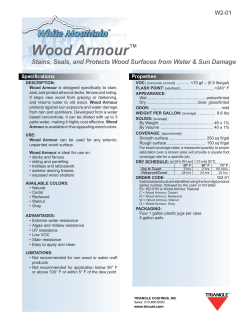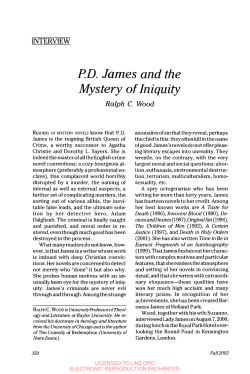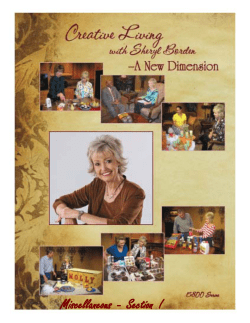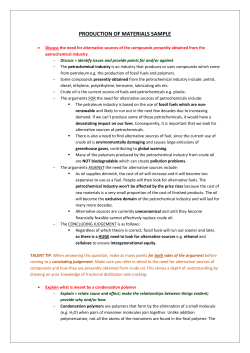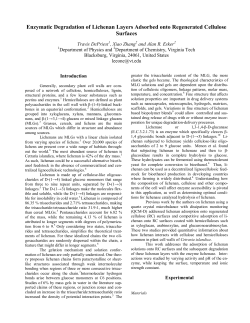
Pr oducts Made Fr om W
Department of Forestry Fact Sheet FORFS 02-02
Pr
oducts Made Fr
om Wood
Products
From
Terry Conners, Extension Specialist in Forest Products
List created July, 2002 from a number of other lists, with additions.
Corrections and Additions will be welcomed! (tconners@uky.edu)
Solid Wood Pr
oducts
Products
Lumber and plywood to build new homes
Doors
Window frames and sills
Flooring
I-joists
LVL (laminated veneer lumber)
Parallel strand lumber
Finger-jointed lumber
Machine stress-rated lumber
Coat racks
Furniture
Dining room tables
Upholstered furniture frames
Rocking chairs
End tables
Coffee tables
Beds
Bookcases
Nightstands
Bureaus
Landscape timbers
Highway guard rails
Snowshoes
Toothpicks
Match sticks
Chopsticks
Shutters
Baseball bats
Canoe paddles and oars
Musical instruments:
Guitars
Pianos
Organs and organ pedals
Oboes
Bagpipes
Banjos
Clarinets
Flutes/Fifes
Mandolins
String bass
Violins
Violin bows
Cellos
Bassoons
Drums
Drum Sticks
Tambourines
Wood blocks
Speaker cabinets
Amplifier cabinets
Metronomes
Xylophones
Harmonicas
Stage flooring
Sandboxes and Backyard play sets
Charcoal
Tool handles
Toilet plungers
Medicine cabinets
Parallel bars
Vineyard stakes
Toys such as wooden blocks
Rulers
Birdhouses
Fencing, fence posts and rails
Firewood
Fishing boats
Ladders
Hockey sticks
Dog houses
Pallets
Particleboard
Medium density fiberboard (MDF) (used
in kitchen cabinets and furniture
panels, for example)
Hardboard
Garage doors
Gazebos
Hot tubs and spas
Lath
Trellises
Kitchen utensils
Pencils
Ping Pong paddles
Golf tees
Animal bedding
Railroad ties
Seesaws
Model airplanes
Coffins
1
Brush handles
Cable reels
Canes
Cedar chests
Cedar closet lining
Activated charcoal
Church pews and altars
Closet rods
Barrels
Crutches
Desks
Docks
Decks
Kitchen cabinets
Ferryboats
Gazebos
Grandfather clocks
Stair rails
Truck and trailer flooring
Mouldings and baseboards
Paneling
Picnic tables
Pilings for building construction
Popsicle sticks
Porch swings
Produce crates and boxes
Propeller shaft bearings for ships
Rocking horses
Rowboats
Shingles
House siding
Putty-type of wood filler
Tongue depressors
Totem poles
Sleds
Salad bowls and serving ware
Telephone poles
Wheelbarrow handles
Wood carvings
Wooden nickels
Pegboard
Ship masts and yardarms
Toilet seats
Piano keys (wooden)
Rolling pins
Knife handles
Childrenís puzzles
Work benches
Toboggans
Bookcases
Park benches
Gun racks and cabinets
Billboards
Snow fences
Trellises
Parallel bars
Log houses
Bowling alley lanes
Bowling pins
Railroad crossing gates
Rural bridges
Tent poles
Hurdles
Lobster pots and floats
Wooden matches
Parts of snowboards, skis
and skateboards
Ventriloquist dummies
Name tags
Flagpoles (for smaller flags)
Cribs
Police batons
Planters
Dowels
Scaffold planks
Concrete forms
Glu-lam beams (used to
create long open
spaces, as in
churches)
Excelsior
Veneer
Bushel baskets
Pants hangers
Kitchen counters
Woodcut artwork
Merry-go-Round horses
Birdhouses
Snowshoes
Woodworking clamps
Spinning wheels
Baskets
Novelties such as Nutcrackers
Checker sets
Jewelry boxes
Foundry patterns
Crates
Garage doors
Theatre scenery
Gunstocks
Beehives
Mallets
Butcher blocks
Organ pipes
Crucifixes
Drafting tables
Ballot boxes
Doll houses
Test tube racks
Wine racks
Handrails
Stake-body truck sides
Gerbil chew sticks (balsa wood)
Yo-yos
Dice
Silverware chests
Venetian blinds
Billiard cue sticks
Fuel for meat smokers
Spices and flavorings
Allspice
Annatto
Bay leaves
Cinnamon
Cloves
FilÈ (Sassafras leaves, used to
thicken gumbos)
Juniper berries (gin flavoring)
Mace
Nutmeg
Orange blossoms (flavored
water)
Chips for smoking meat
Sassafras oil is used as a soap
perfume
Logs provide nutrients for shiitake
mushrooms
Cutting boards
Model airplanes
ìBiscuitsî for wood joining
Products that Used to be Made
Fr
om Wood
From
(Some of these may still be made from
wood for specialty products.)
Water pipes
Bocce balls
Tennis rackets
Car dashboards
Golf clubs
Conestoga wagons
Clocks and clock gears
Waterwheels
Printing press type
Printing presses
Deckle boxes (frames used to make paper
by hand)
Paper presses (to squeeze the water out
of handmade paper)
Woodworking planes
Cigar store Indians
Weaving shuttles and bobbins
Wooden shoes
Bows and arrows
Wooden wheels for automobiles and
wagons
Pull toys
Sextants
Street paving blocks
2
Rocking horses
Fun house barrels
Fishing lures
Storage battery separators (hard rubber)
Water tanks
Wardrobes/armoires
Model ìTî coil boxes
Automobile chassis
Ironing boards
Treenails
Post and beam timber framing
Cabinets for Analytical balances
Shoe lasts
Radio, television and phonograph/stereo
cabinets
Butter churns
Harpsichords
Railroad cars
Aircraft propellers and airframes
Minesweeper boats, PT boats
Silos
Fermentation vats
Cigar boxes
Racing shells (one to eight-man rowed
boats)
Wringers for washing machines
Telephones
Wood creosote used to be used as a
laxative, a disinfectant and a cough
treatment (rarely used nowadays).
Woodworking tools
Planes
Carpenter levels
Carpenter rules
Tool chests
Gear shift knobs
Butter molds
Slide rules
Phonographs
Bicycles
Travelerís writing desks
Cigar molds
Artistís pallets
Washboards
Skis
Water well structures
Water pump enclosures
Wheel chairs
Candlesticks
Warships
Wardrobe trunks
Maple syrup buckets
Abacus
Pulleys
Gallows
Milking stools
Insulator pins
Plates and bowls
Artificial limbs
Sled runners
Iceboxes and refrigerators
Gutters
Spruce gum was used for chewing gum
Sassafras tea
Canoes
Automobile tires (used rayon as reinforcing cord)
Shoe pegs (used to fasten shoe soles to
the leather uppers)
Dragonís blood (from fruit of Asian tree)
was used in the manufacture of
varnishes and lacquers
Dyestuffs (prior to invention of synthetic
dyes)
Canada balsam (tree resin) was used to
make microscope slides
Quinine came from the bark of the
Cinchona tree
Willow bark provided the original source
of aspirin-like compounds
Cork used to be the gasket material lining
bottle caps
Rubber used to be used to waterproof
raincoats
Molded wooden figurines
Typewriter keys (Celluloid)
Red elm inner bark used to be steeped in
water to obtain a remedy for sore
throats
Hickory was a part of the Wright
brothersí airplanes
Cylinder phonograph records used to be
made from Carnauba wax because it
is so hard
Tool handles were made from celluloid as
recently as World War II.
Piano keys were once made from celluloid
as an ivory substitute.
Things Made fr
om Wood that
from
Formerly Wer
e
om
ere Made fr
from
Something Else
Paper (used to be made from cotton and
linen rags)
Non-W
ood/Non-Paper Pr
oducts
Non-Wood/Non-Paper
Products
Shade!
Nuts
Cola nuts (Coca-Cola etc.)
Almonds
Brazil nuts
Cashews
Hazelnuts
Pistachios
Walnuts
Pecans
Hickory nuts
Chestnuts
Pine nuts
Acorns (decorative uses)
Fruits
Apples
Avocadoes
Coffee
Peaches
Oranges
Lemons
Limes
Bananas
Pears
Tangerines
Coconuts
Dates
Grapefruit
Olives and olive oil
Plums
Figs
Fruit juices
Carob (a cocoa substitute)
Cider
Mistletoe (grows as a symbiant on trees)
Eucalyptus leaves (floral component, also
used for fragrance)
Carnauba wax (from the leaves of the
carnauba palm tree grown in Brazil).
Used in:
Shoe polish
Lipsticks
Automotive waxes
Furniture polish
Applied to produce to
make it look appealing
in supermarkets.
Products from Wood Sap or Extractives:
Citrus cleaners (oils)
Lime scent for aftershave
Sandalwood fragrance for soap
and incense
Maple syrup
Rubber
Rubber products
Golf balls
Tires
Marine and underwater
cable insulation
Adhesives
Combs (hard rubber)
Latex gloves and other
barrier-type of
medical products
Rubber belts
Rubber hoses
Gaskets
Shoe soles
Rubber boots
Rubber balls
Turpentine (most of it comes
from wood pulping
operations)
Rosin
Pine needle extract (an antiinflammatory)
Rosewood oil (various medicinal
uses)
Taxol (anti-cancer drug)
Frankincense
Myrrh
3
Tea tree oil (antibiotic and
antifungal oil)
Benzoin gum
Gum Arabic
Corks (the primary use for cork: ~17
billion sold each year, compared to
400 million for plastic stoppers
(2001 statistics))
Other cork products
Coasters
Flooring
Dartboards
Wall and ceiling tiles
Sanding blocks
Corkboards
Expansion joint filler
Insulation corkboard
Fishing buoys and floats
Cork washers
Hot pads
Musical instrument parts (e.g.,
stoppers for organ pipes)
Laboratory rings for glassware
Bathmats (made of granulated
cork)
ìPeasî for whistles
Cricket balls
Corks for pop guns
Foosball (table football) balls
Hockey balls
Baseballs
Facings for some ping pong
paddles
Cork shoe soles
Roofing
Products that Used to be
Made From Cork
(Some of these may still be made as
specialty products.)
Bottle caps gaskets for carbonated
beverages
Life jackets (until 1857 ñ now mostly
polystyrene)
Life preservers (polystyrene now)
Fishing rod handles (now mostly
HypalonÆ)
Sheet insulation (e.g., for refrigerators)
Rocket nosecones (a cork-ceramic
composite)
Paper and Fluff Products
Computer and copy paper
Book paper
Book marks
Envelopes
Checkbooks
Bulk mail
Bills
Instruction manuals
Packaging cards for blister-packed
products
Calendars
Diplomas and Certificates
Report cards
Lamp shades
Book covers
Concert posters
Identification badges
Newsletters
Recipe cards
Salt boxes
Sugar and flour bags
Can labels (except for tomato cans for
some unknown reason!)
Bottle and jar labels
Cereal boxes
Shelf labels in grocery stores
Adhesive-backed labels
Receipts
Menus
Poster board
Baking cups
Coupons
US currency is not made from wood pulp
ñ itís made from cotton and flax
fibers
Coffee filters
Facial and bath tissue
Packaging for facial and bath tissue (the
boxes and wrappers)
Napkins
Sanitary and surgical absorbent products
Disposable diapers
Kites
Catalogs
Game boards
Masking tape
Crepe paper
Birthday and Christmas wrapping paper
Stickers
Coloring books
Flashlight battery labels
Paper dolls
Baseball cards
Tracing paper
Election ballots
Milk cartons
Egg cartons
Postage stamps
Paper towels
Playing cards
Building insulation, loose and in panel
form
Grocery Bags
Paper Cups
File Folders
Post-It NotesÆ
CD labels
DVD and VCR tape packaging
Magazines
Magazine card inserts
Postcards
Maps
Fast food packaging
Frozen food boxes
Construction paper
Kraft paper (wrapping paper)
Multi-wall sacks for birdseed and pet
foods
Price tags
Sandpaper
Seed starter blocks
Loudspeaker cones
Origami paper
Tea bags are usually not made from wood
pulp ñ they are mostly made from
abaca, also known as Manila hemp
Tea bag labels are made of wood-based
paper
Cigarette papers and vacuum cleaner bags
are made from hemp or flax fiber!
Bible paper
Wallpaper
Tubes for bathroom tissue and paper
towels
Artificial snow (paper snow)
Wax paper
Confetti
Admixture with sprayed-on grass seed
Food additive (non-digestible cellulose
dietary fiber). Used in diet drink
products, food texture enhancer. (In
the late 1970s, a ìdiet breadî used
cellulose fiber from wood as one of
its ingredients.)
Butcher paper
Musical instrument cases (ìcardboardî
type, as for guitars)
Phone books
Photographs
Newspapers
Tickets
Business cards
Roofing felt
Ice cream containers
Pizza boxes
Disposable tablecloths
Retail software boxes
Corrugated cartons
Ceiling tiles
Absorbent socks for oil spills
Absorbent liners for supermarket meat
trays
Stationery and notebook paper
NCR (no carbon required) paper
Tax forms
Marriage licenses, birth and death
certificates and other civil documents
Racing forms
Programs for sporting events
Fiber filler for plastics:
Tool handles
Football helmets
Buttons
Eyeglass frames
4
Ball point pens
Electronics cases (televisions,
calculators, computers)
Loudspeakers
Automobile parts (e.g., door panels)
Packaging
Trays
Thermoformed products like gun
cases
Marine/Trailer flooring
Wood-plastic composite lumber:
Garden benches
Picnic tables
Planters
Fencing
Decking
Signs
Parking stops for parking lots
Spare tire covers
Melamine paper-faced board
Things that Formerly Wer
eree
Made fr
om Wood-based Paper
from
Oil cans
Candy bar wrappers
Grocery bags (some still are made from
paper!)
Library catalog cards (supplanted by
computer files)
Drinking straws
Shotgun cartridges
Carbon paper
Bumper stickers (now made out of vinyl
except for the peel-off paper on the
backside)
Computer cards (now entirely electronic!)
Pr
oducts Made fr
om WoodProducts
from
Derived Chemicals
(Processed products, not oils or latex,
etc. Some cellulose products may derive
from other cellulose sources such as
cotton linters, depending on economics
and manufacturer.)
Textiles (Rayon, Tencelô)
Cellulose acetate (wrapping and photographic film)
Cellulose nitrate (former composition of
movie film, except that it was very
flammable and unstable with age)
Celluloid (rarely produced nowadays,
except for guitar picks and pick
guards, fountain pens, accordion
cases and ping-pong balls. Formerly
used for costume jewelry, clocks,
etc.)
Cellulose acetate and cellulose nitrate are
both used in adhesives and lacquers.
CMC (carboxymethyl cellulose) is used as
a food thickener and texturizer for
products such as ketchup and ice
cream (depending on manufacturer);
also used to stabilize oil well drilling
muds.
Cellulose-based pill fillers
Cellophane (wrapping material, also used
for Easter basket grass!)
Toothpaste additives (e.g., cellulose gum)
ìPlasticî twine
Hardhats and sports helmets
Cigarette filters (cellulose acetate fibers)
Cellulose industrial filters
Sausage casings
Cellulose spongesArtificial vanilla
flavoring (by-product of Kraft process
pulping)
Cleaning compounds
Chewing gum is a combination of natural
rubber (especially chicle, from the
Sapodilla trees from Central and
South America) with some
synthetic latexes to extend the
natural latex supply. Other wood
chemicals such as rosin esters and
terpenes are also common ingredients.
Additive to unfired ceramics to give them
strength
Fungicides
Hair spray
Cosmetics ñ including thickeners such as
methyl cellulose and
methyl†hydroxy†ethyl†cellulose
Methanol (used in colognes, solvents)
Torula yeast (a food supplement) is
grown on wood sugars and wood
mineral nutrients leftover from
pulping operations. This is used in
baby foods, imitation bacon,
cereals, baked goods, etc.
Tannin (used in natural tanning process,
less common than formerly)
Carnauba wax is commonly used as a pill
coating.
Liquid SmokeÆ
Linoleum (oxidized linseed oil mixed with
pine resin and wood flour)
Acetic acid (produced by distillation of
wood)
Biofuels from wood distillation
Liquid nail polish
Shaving cream (tea tree oil, camphor, etc.,
varies by manufacturer)
Suntan lotion (e.g., almond oil (emollient);
clove bud oil (scent); cocoa butter
(emollient))
Ink (incorporate tall oil rosins from hard
pines)
Tall oil fatty acids and derivatives are used
as:
PVC stabilizers
Synthetic lubricants
Polyamides
Corrosion inhibitors
Soaps
Detergents
Emulsifiers
Rubber processing additives
Asphalt additives
Concrete additives
Epoxy additives
Plasticizers
Metalworking chemicals
Oil field chemicals
Rosin-based adhesive products
Also, see the list of products from
Extractives (above)
To gr
ow a pound of wood, a tr
ee uses 1.47 pounds of carbon dioxide and gives of
grow
tree
offf 1.07 pounds of oxygen.
The following information is copied fr
om the website of the Temperate For
est Foundation {http://www
.for
estinfo.org/
Forest
{http://www.for
.forestinfo.org/
from
Discover/facts.htm#Recycling}:
∑
In 1995, some 1.6 billion seedlings were planted in the U.S. - more than 5 new trees a year for every American.†
Millions of additional trees were naturally reforested.
∑
Private owners account for 59% of the nationís 490 million acres of commercial forestland; government owns
27%; and the forest industry owns 14%.
∑
Each person in the United States consumes approximately 675 pounds of paper a year.
∑
On the average, everyone uses the equivalent of a tree, 18 inches in diameter - 100 foot tall, every year. Thatís 80
cubic feet!
The United States is a wood-rich country; people in the United States (on average) use about three times as much wood
each day as people in the rest of the world. One of the most common uses for wood around the world is for fuel!
And finally
finally,, a surprise for (almost) all Kentuckians:
3M Corporationís popular product, Post-It Notes, are manufactured exclusively in Cynthiana, (Harrison County),
Kentucky!
(T. Conners 07/02)
Educational programs of the Kentucky Cooperative Extension Service serve all people regardless of race, color, age, sex, religion, disability,
or national origin. Issued in furtherance of Cooperative Extension work, Acts of May 8 and June 30, 1914, in cooperation with the U.S.
Department of Agriculture, M. Scott Smith, Director of Cooperative Extension Service, University of Kentucky College of Agriculture,
Lexington, and Kentucky State University, Frankfort. Copyright © 2002 for materials developed by the University of Kentucky Cooperative
Extension Service. This publication may be reproduced in portions or its entirety for educational or nonprofit purposes only. Permitted users
shall give credit to the author(s) and include this copyright notice. Publications are also available on the world wide web at: http://www.uky.edu/
Agriculture/Forestry/forestry.html.
5
© Copyright 2025










